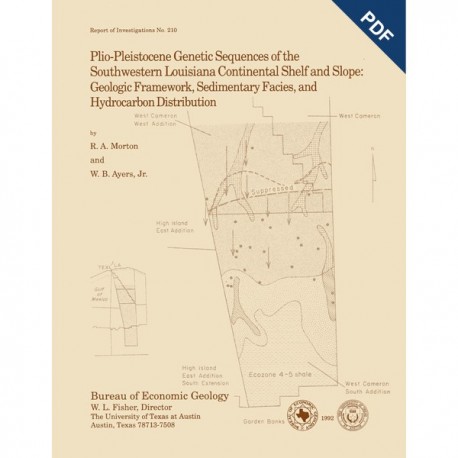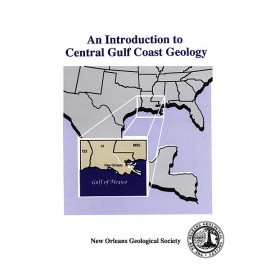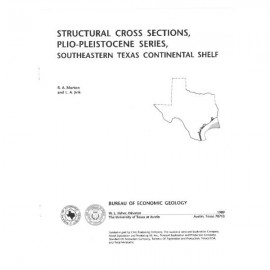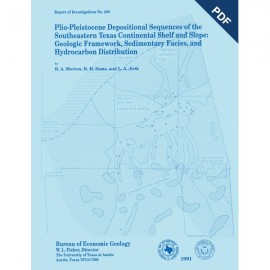Reports of Investigations
-
Books & Reports
- Reports of Investigations
- Guidebooks
- Udden Series
- Geological Circulars
- Down To Earth
- Atlases of Major Oil and Gas Reservoirs
- Texas Memorial Museum Publications
- Environmental Geologic Atlas of the Texas Coastal Zone
- Mineral Resource Circulars
- Other Reports
- Seminars and Workshops
- Handbooks
- Submerged Lands of Texas
- Symposia
- Annual Reports
- Open File Reports
-
Maps & Cross Sections
- Thematic Maps
- Miscellaneous Maps, Charts & Sections
- Geologic Atlas of Texas
- STATEMAP Project Maps
- Geologic Quadrangle Maps
- Cross Sections
- Highway Geology Map
- Energy and Mineral Resource Maps
- Shoreline Change and Other Posters
- Wilcox Group, East Texas, Geological / Hydrological Folios
- Bouguer Gravity Atlas of Texas
- River Basin Regional Studies
- Featured Maps
- Posters
- Teachers & the Public
-
Geological Society Publications
- Gulf Coast Association of Geological Societies
- Alabama Geological Society
- Austin Geological Society
- Corpus Christi Geological Society
- Houston Geological Society
- Lafayette Geological Society
- Mississippi Geological Society
- New Orleans Geological Society
- South Texas Geological Society
- GCS SEPM Publications
- Historic BEG & UT Series
Plio-Pleistocene Genetic Sequences of... Southwestern Louisiana Continental Shelf and Slope. Digital Download
RI0210D
For a print version: RI0210.
RI0210D. Plio-Pleistocene Genetic Sequences of the Southwestern Louisiana Continental Shelf and Slope: Geologic Framework, Sedimentary Facies, and Hydrocarbon Distribution, by R. A. Morton and W. B. Ayers, Jr. 77 p., 1 table, 35 figs., 1 appendix, 1992. doi.org/10.23867/RI0210D. Downloadable PDF.
To purchase this publication in book format, please order RI0210.
ABSTRACT
The Plio-Pleistocene hydrocarbon fairway of offshore western Louisiana is restricted to the outer continental shelf and upper continental slope where a thick wedge of nearshore and deep-marine sediments was deposited. Electric logs, paleontological reports, and seismic profiles form the basis for (1) dividing the wedge of Plio-Pleistocene strata into eight genetic sequences, (2) establishing the structural framework, (3) determining the timing of deformation, and (4) mapping the principal depositional systems of the West Cameron and western Garden Banks Areas during the past 5 m.y. Sedimentary facies and structural styles in this part of the Gulf Coast Basin are highly variable owing to contemporaneous sea-level fluctuations, salt migration, and shifting sites of deltaic, shelf, and slope sedimentation. The complex geologic history of this part of the basin controlled the generation, migration, and entrapment of hydrocarbons.
During the early Pliocene the continental platform became inundated, and a thick succession of marine mudstones was deposited. About 3 mya this accumulation of deep-water mudstone was interrupted by deposition of sand-rich submarine channels and fans associated with a lowering sea level. These lowstand deposits extended at least 55 mi (90 km) basinward of the paleoshelf margin. Overlying Pleistocene sediments were deposited mainly by prograding mud-rich fluvial-deltaic systems of moderate size. The rivers and shelf-edge deltas constructed a broad continental platform that buried the submarine fans and prograded the shelf margin approximately 70 mi (110 km) basinward. During this rapid outbuilding, slumping and other gravity-driven mass transport processes removed sand-rich delta-front sediments from unstable shelf margins and redeposited them on the continental slope.
Plio-Pleistocene reservoirs in the West Cameron and western Garden Banks Areas contain more than 1.1 billion barrels of oil equivalent distributed among at least 100 different fields or local accumulations. Most of the fields are located near faults associated with relatively recent salt movement, although a few fields are located near shallow salt diapirs. The fields have been grouped into six exploration plays on the basis of structural style, reservoir facies, and hydrocarbon composition. The most prolific play has stacked delta-front reservoirs, which produce from broad rollover anticlines that formed in a graben complex between the Trimosina regional and counterregional fault systems. Each play primarily produces gas, although some oil is produced from fields beneath the continental slope. New field discoveries and reserve growth are likely in all six plays because of deeper drilling or off-structure exploration in former intraslope subbasins.
Keywords: depositional system, genetic sequence, Gulf Coast, hydrocarbons, offshore Louisiana, Plio-Pleistocene
CONTENTS
Abstract
Introduction
Regional Setting
Sources of Data
Electric Logs
Paleontological Reports
Seismic Profiles
Climatic and Eustatic Fluctuations
Pliocene-Pleistocene Boundary
Structural Framework
Principal Structural Features
Extensional Faults
Shale and Salt Diapirs
Unconformities
Structural Styles
Timing of Structural Movement
Depositional Systems, Systems Tracts, and Genetic Stratigraphic Sequences
Depositional Systems
Shelf-Edge Delta Systems
Slope Systems
Depositional Systems Tracts
Sequence Boundaries and Offshore Sequences
Onshore Formations
Plio-Pleistocene Stratigraphic Framework
Mapping Depositional Systems and Shelf Margins
Characteristics of Plio-Pleistocene Genetic Stratigraphic Sequences
Pre-Robulus E (not mapped)
Robulus E to Buliminella 1 (Sequence 1)
Buliminella 1 to Globoquadrina altispira (Sequence 2)
Globoquadrina altispira to Lenticulina 1 (Sequence 3)
Lenticulina 1 to Angulogerina B (Sequence 4)
Angulogerina l3 to Hyalinea balthica (Sequence 5)
Hyalinea balthica to Trimosina A (Sequence 6)
Trimosina A to Globorotalia flexuosa (Sequence 7)
Post-Globorotalia flexuosa (Sequence 8)
Summary of Depositional and Structural History
Late Miocene and Early Pliocene
Middle Pliocene
Late Pliocene
Early Pleistocene
Middle Pleistocene
Late Pleistocene
Hydrocarbon Generation and Distribution
Source-Rock Potential, Thermal Maturation, and Petroleum Migration
Spatial Distribution of Hydrocarbons
Delineation of Hydrocarbon Plays
Play Characteristics and Exploration
Play 1
Play 2
Play 3
Play 4
Play 5
Play 6
Summary and Conclusions
Acknowledgments
References
Appendix: Plio-Pleistocene recoverable reserves and cumulative field production by play
Figures
1. Chronostratigraphic and biostratigraphic subdivision of Plio-Pleistocene strata in the western Gulf Coast Basin
2. Schematic cross section of Plio-Pleistocene strata in the West Cameron and western Garden Banks Areas showing the lithologic and biostratigraphic criteria used to correlate genetic sequences
3. Regional depositional framework of Plio-Pleistocene strata
4. Structural features of the southwestern Louisiana continental shelf and slope, Plio-Pleistocene productive trend
5. Structural cross section derived from seismic profile illustrating lithofacies, stratigraphic subdivisions, and structural style in the north sector of the study area
6. Structural cross section derived from seismic profile illustrating lithofacies, stratigraphic subdivisions, and structural style near the east margin of the study area
7. Structural cross section derived from seismic profile illustrating lithofacies, stratigraphic subdivisions, and structural style near the center of the study area
8. Structural cross section derived from seismic profile illustrating lithofacies, stratigraphic subdivisions, and structural style near the west margin of the study area
9. Structural cross section derived from seismic profile illustrating lithofacies, stratigraphic subdivisions, and structural style of the upper continental slope
10. Typical electric log responses
11. Net-sandstone map of sequence 1 (Robulus E to Buliminella 1)
12. Percent-sandstone map of sequence 1 (Robulus E to Buliminella 1)
13. Depositional systems map of sequence 1 (Robulus E to Buliminella
14. Net-sandstone map of sequence 2 (Buliminella 1 to Globoquadrina altispira)
15. Percent-sandstone map of sequence 2 (Buliminella 1 to Globoquadrina altispira).
16. Depositional systems map of sequence 2 (Buliminella 1 to Globoquadrina altispira)
17. Net-sandstone map of sequence 3 (Globoquadrina altispira to Lenticulina 1) 36
18. Percent-sandstone map of sequence 3 (Globoquadrina altispira to Lenticulina 1)
19. Depositional systems map of sequence 3 (Globoquadrina altispira to Lenticulina 1).
20. Net-sandstone map of sequence 4 (Lenticulina 1 to Angulogerina B
21. Percent-sandstone map of sequence 4 (Lenticulina 1 to Angulogerina B)
22. Depositional systems map of sequence 4 (Lenticulina 1 to Angulogerina B)
23. Composite net-sandstone map for pre-Hyalinea balthica sand-rich submarine fans penetrated in the northern Garden Banks Area
24. Net-sandstone map of sequence 5 (Angulogerina B to Uyalinea balthica)
25. Percent-sandstone map of sequence 5 (Angulogerina B to Hyalinea balthica)
26. Depositional systems map of sequence 5 (Angulogerina B to Hyalinea balthica)
27. Net-sandstone map of sequence 6 (Hyalinea balthica to Trimosina A)
28. Percent-sandstone map of sequence 6 (Hyalinea balthica to Trimosina A)
29. Depositional systems map of sequence 6 (Hyalinea balthica to Trimosina A)
30. Net-sandstone map of sequence 7 (Trimosina A to Globorotalia flexuosa)
31. Percent-sandstone map of sequence 7 (Trimosina A to Globorotalia flexuosa)
32. Depositional systems map of sequence 7 (Trimosina A to Globorotalia flexuosa)
33. Distribution of Plio-Pleistocene oil and gas fields, West Cameron and western Garden Banks Areas and their subdivision into principal exploration plays
34. Sizes of known Plio-Pleistocene oil and gas fields, West Cameron and western Garden Banks Areas, determined on the basis of recoverable reserves
35. Cumulative production and recoverable reserves for each Plio-Pleistocene play, West Cameron and western Garden Banks Areas
Table
1. Summary of geologic characteristics and exploration potential of Plio-Pleistocene hydrocarbon plays,
West Cameron and western Garden Banks Areas
Plates
1. Structural cross section 1-1'
2. Structural cross section 2-2'
3. Structural cross section 3-3'
Citation
Morton, R. A., and Ayers, W. B., Jr., 1992, Plio-Pleistocene Genetic Sequences of the Southwestern Louisiana Continental Shelf and Slope: Geologic Framework, Sedimentary Facies, and Hydrocarbon Distribution: The University of Texas at Austin, Bureau of Economic Geology, Report of Investigations No. 210, 77 p.





